

Latino community mourning loss of an “exceptional” couple known for helping others
KALAMAZOO, Mich. — Juan Muniz was always helping people in the city’s Latino community, said their friends at El Concilio. Whether it was addressing the needs of the people on the radio or helping a senior citizen find employment, he was doing something to serve others.
“He definitely was someone who was constantly on the move, trying to find ways of helping people,” said Lissette Mira-Amaya with a smile. “And so ways Maria. We cannot forget Maria.”
Muniz’s wife — who also went by Mary — was always by his side, said Mira-Amaya who’s known them for decades. According to police they were both tragically killed Tuesday night in a car crash…
Link to article
Autentico: The Definitive Guide to Latino Career Success
R Rodriguez, AT Tapia – 2017
… When Judith Turnock and I wrote Cracking the Corporate Code we were aware that although
the book was about the success of the thirty-two African-Americans we cited, interest in the book
would go far beyond that group. … FRIDA KAHLO, Mexican painter W hy of whom this …
Link to book preview
Facebook Researchers Shut Down Artificial Intelligence That Created It’s Own Language
Facebook has recently developed a new artificial intelligence (AI), and it has since created its own language using code words to communicate more efficiently. Researchers promptly shut the system down over concerns that they might lose control over the A.I.
This isn’t the first time AIs have diverged from their training in the English language to develop their own, more efficient language. While the resulting phrases from this condensed method of communication sound like gibberish to the human ear, they do in fact make semantic sense when interpreted by AI agents…
Link to article
A Man of Letters
Francisco Lomelí is one of the busiest men in Spanish publishing at the moment. The professor of Chicano and Chicana Studies and of Spanish and Portuguese at UC Santa Barbara has three works out now — a reference book on Latino literature, a revised and updated anthology of essays on Aztlán and a magazine of Latino arts and literature…
Link to article
Beyond the Spitfire: Re-visioning Latinas in Sylvia Morales’ A Crushing Love 2009
From Dolores del Río to Salma Hayek and from Lupe Vélez to Eva Longoria, the portrayal of
Latinas in the United States has provoked debate, criticism and controversy. Since the era of
silent movies, Hollywood’s depiction of the Latina has been rigidly prescribed and reductive…
Link to book preview
RANKING: Top 10 Video Platforms Preferred by US Hispanics
Which video platforms do US Hispanic users prefer? What types of content do they provide? Does gender play a role in audiovisual content preference? Read on for the answers to these questions, drawn from comScore’s February 2016 ranking…
Link to article
Phoenix seeks input on building Latino arts and cultural center
A cultural center showcasing Latino communities may be Phoenix’s next major investment in city art institutions.
Some Phoenix leaders and organizations have for years pushed for a space to highlight the artistic contributions of Latinos through a designated facility, without a designated funding source or plan. Now, the city is considering if nearly $1.4 million in bond funding could launch the project.
There’s no precise vision, location or business model — yet. A consultant approved by the City Council last year is investigating how such a center would function.
The institution would aim to hold exhibitions and programs that focus on cultural education and celebration. Early outreach to artists and an advisory board for the proposal point to interest in a multipurpose space that could include visual and performing arts as well as classroom and event space, said Evonne Gallardo, the California-based consultant working on the project…
Link to article
Mitú Partners With Snapchat To Create Content For Latino Youth
mitú, a digital network for Latino millennials, announced Monday the launch of its channel on Snapchat Discover. The new partnership will help Snap become a leader in delivering English language content with a Latino lens on Snapchat Discover…
Link to article
Access Latina is Looking to Boost Successful Latina Entrepreneurs
Latina entrepreneurs are among the fastest growing and industrious business owners in the United States, and one organization is looking to give a leg up to promising companies.
Access Latina, which is completely run by women, provides a platform for promising and pioneering Hispanic women who need capital or guidance to further grow their businesses. The platform seeks to uplift Hispanic women working in agriculture, social innovation and STEM fields…
Link to article
Mexican American Proarchive: Annual Report on Mexican American Professionals
News from the census American Community Survey is generally good for the 2015 year. Mexican American college enrollment was up from 18.7% to 18.9% in the 2014 and 2015 years. Graduate or professional degree attainment was also up from 2.9% to 3.0%. The number of bachelor’s degrees granted to Mexican American students rose from 7.6% in 2014 to 7.8% in 2015.


In spite of these gains, Mexican Americans still remain at the bottom of the ladder when it comes to earning a bachelor’s degree. Even after broadening the group to Latinos or Hispanics, this group still lags behind. According to the Pew Hispanic Center: “As of 2014, among Hispanics ages 25 to 29, just 15% of Hispanics have a bachelor’s degree or higher. By comparison, among the same age group, about 41% of whites have a bachelor’s degree or higher (as do 22% of blacks and 63% of Asians).” Pew reports that the main reasons for this low graduation rate is that Hispanics are less likely “to enroll in a four-year college, attend an academically selective college and enroll full-time.”
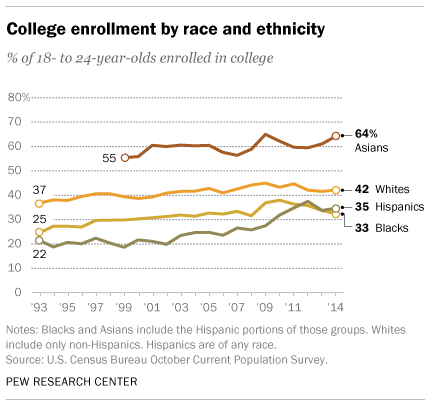
Also in the good news column, the University of California will continue to push for a greater number of underrepresented minorities; namely, Chicano/Latino students whose resident freshmen numbers rose from 2.7% to 32.3% of admitted California freshmen. In other good news, the proportion of Chicano/Latino students transferring from community colleges increased to 29.3% from 26.8% for 2015.
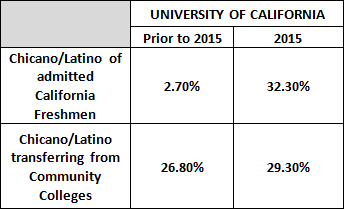
Occupations, including those in management, business, science, and art, fared better for Mexican Americans. The number of Mexican Americans filling these occupations rose from 17.4% in 2014 to 17.5% in 2015.

The total number of Hispanics filling these occupations was 16.1% in 2015, a bit lower than Mexican Americans specifically.
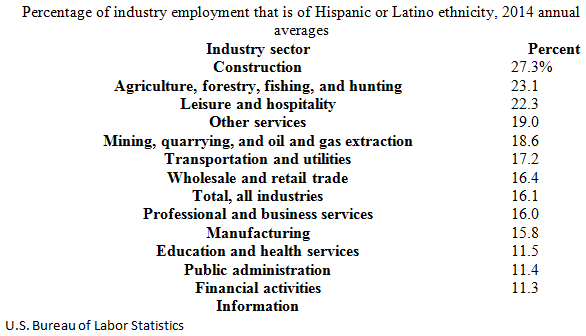
The report shows that industrial employment for Mexican Americans remained the same for 2014 and 2015 at 10.2%.
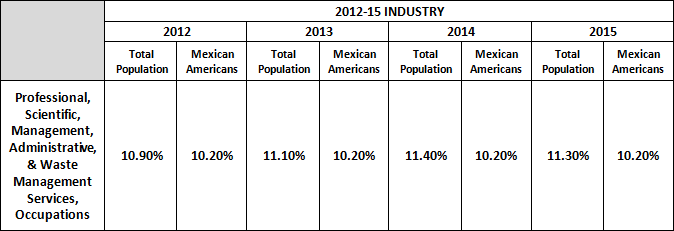
The figures for Hispanic or Latino employment for 2015 and 2016 show a healthy increase.
According to the Pew Hispanic center, “Construction, professional and business services, health services, financial services and food services…showed healthy gains.” Most of the jobs gained by native-born Hispanic workers were in manufacturing, mostly durable goods (82,000 Hispanic workers in this industry), followed by wholesale and retail trade (79,000), publishing, broadcasting, communication and information services (55,000), and construction (54,000).
Foreign-born Hispanics had the most job gains in construction (417,000), followed by business and professional services (179,000). Together, those two industries accounted for almost three-quarters (74%) of all jobs gained by foreign-born Latinos between 2005 and 2006.
The business and professional services sector, which ranges from management and technical services to janitorial, landscaping, and waste management services, is also a key employer for non-Hispanic workers. Of the total increase in employment in 2005-06, non-Hispanic workers accounted for 410,000 employees in the industry, native-born workers 327,000, and foreign-born workers 83,000.
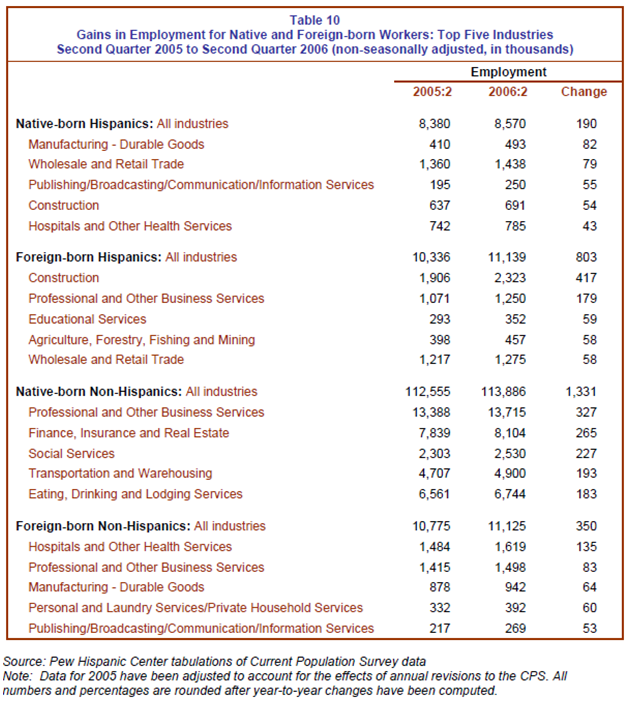
Sources
- Census Bureau, Selected Population Profile in the United States: 2015
- Pew Research Center
- University of California
- Bureau of Labor Statistics
How Hispanic culture is changing America
This article is part of an ongoing Media Life series entitled “Catching the next big wave: Hispanic media.” You can read previous stories by clicking here.
Last month, Univision Deportes Network beat every other cable sports network in primetime among the key demos of adults 18-49 and 18-34.
It finished ahead of Fox Sports 1 and NBC Sports Network, which is an accomplishment of itself.
But it also beat cable sports’ big dogs, ESPN and ESPN2.
UDN carried the Copa America Centenario in June, which explains the big ratings, while the other networks were in a rare summertime lull between major events like NASCAR and the Tour de France.
But still, a Spanish-language network beating a bunch of English-language ones in the major sports demos?
A few years ago, that would have been unthinkable. In fact, five years ago, UDN didn’t even exist…
Link to article


